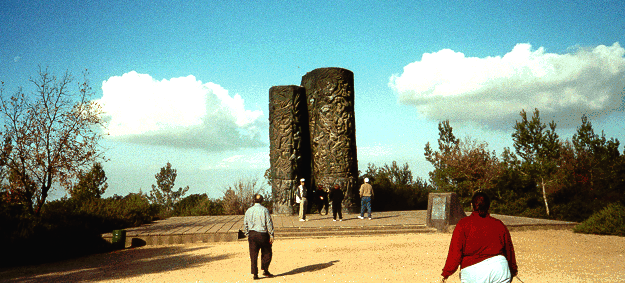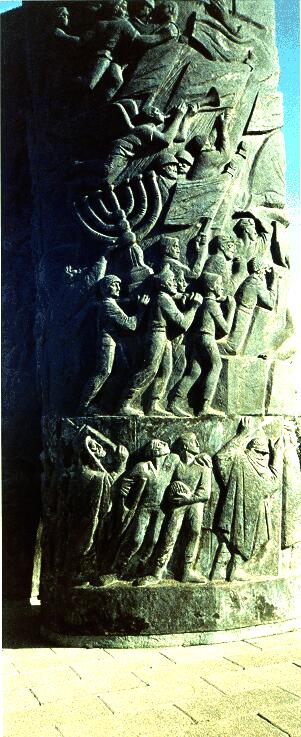 |
|
|
|
|
|
|
|
|
|
|
|
|
|
|
|
|
|
|
|
|
|
|
|
|
|
|
|
|
|
|
|
|
|
|
|
|
|
|
|
|
|
|
DAY 1 |
|
|
|
Thursday, 7 January |
|
|
|
We arrived in Tel Aviv early Thursday morning, and after the typical ariport ordeal of passport control, baggage retrieval and money exchange, were on our way to Jerusalem. Taking Highway 1, we followed the same ancient path which connected Jaffa to Jerusalem, passing along the way flatlands, the birthplace of Samson; Gibeon, where Joshua and his army were victorious because "the Lord fought for Israel" (Joshua 10: 14), and the place where Goliath the giant was struck down by a young shepherd boy named David, armed only with a slingshot. We turned off Highway 1 onto a windy, mountainous backroad used during the 1940's and the War of Independance. Centuries old terraces cut into the hillsides, dotted here and there with the red roofs of houses. |
|
|
|
Continuing through the Judean mountains, we made our first stop and disembarked for a brief walk to the Scrolls of Fire, a towering sculpture in the shape of a scroll. Dedicated to the six million Jews killed in the Shoah, the right side of the scroll depicts scenes of devastation and suffering: death camps where bent figures stagger under the brutal gaze of Nazi soldiers whose stone faces are as muted and blank as their souls. The left scroll, in contrast, shows Jewish men and women returning to the Holy Land, ushered in by Elijah blowing a trumpet and David playing his harp. Chiseled into the stone between the two ends of the scroll are these words spoken by the prophet Ezekiel: "Thus says the Lord God: Behold, I will open your graves and raise you from your graves, O my people; and I will bring you home into the land of Israel. And you shall know that I am the Lord." (Ezekiel 37: 12-13) |
|
|
 |
|
|
|
The Scrolls of Fire |
|
|
|
 |
|
|
|
The victorious return
of the Menorah |
|
|
|
|
|
Back on our bus we passed through the Jerusalem Forest, grown thick with pine and eucalyptus trees which, because they are indigenous to climates where the frozen ground yeilds little water, also thrive here. We entered the city of Jerusalem on foot, from the north, and over a low wall on Mount Scopus (from Latin for "view") saw for the first time the city once dominated by the great Temple, though now the sunlight glints off the Golden Dome of the Rock which stands in its place. To the immediate left is the Mount of Olives; sloping down into the Kidron Valley, it is punctuated by the three churches of the Ascension-- one for where each of three Christian traditions claim the event took place. |
|
|
|
All around us, men sold post cards and visitors took pictures; the place bustled with merchants, tourists, and even a donkey led by a small boy, but our group gathered for a prayer. We marked our entry into Jerusalem with a Shehechiyanu ceremony: sweet wine, used specifically for blessings, and bread were blessed and shared as we thanked God for bringing us to such a moment. |
|
|
|
 |
|
|
|
Jerusalem |
|
|
|
En route to our hotel, we travelled through the eastern, Arab section of Jerusalem. Worn down white houses cropped up organically from the hillside; laundry swaying on the line revealed fleeting glimpses of brilliant turquoise and deep midnight blue. The chaotic jumble of houses and colors quickly gave way to a neater, more deliberate organization of buildings as we passed from east to west. The western, Jewish section of the city, although more modern and well-planned, is not immune to its surroundings. Passing one house, our professor pointed out the top story. This was the "last house" between Israel and Jordan in the 1940's; the uppermost level is full of peepholes for guns. |
|
|
|
Quite weary by this point, we were pleased to arrive at the Moutn Zion Hotel. Small, lovely, and not overly commercialized, it is situated directly below the Old City. After what we learned to jokingly refer to as a "light" lunch, several members of our group set out to explore. Father Greg, Bob, Elaine, Rose and I attempted to find Jaffa Gate, but Bob and Fr. Greg espied a "more direct route". After almost forty-five minutes of torturous and oftentimes futile climbing, we reached the Old City, which at first glance appeared to be full of old men selling things. Wandering around a bit led us to the "sukh" (market), where the sights, smells, and (to me) delightful prospect of shopping were somewhat tempered by the shopkeepers continually hovering over us and sometimes following in pursuit. We stumbled eventually into the Jewish, Christian and Armenian Quarters, saw a camel, wandered some more, and then decided to go home. Bob, no doubt in the process of trying to find a more direct route back, spotted another member of our group, and so after meeting Liz we returned to the Old City for some coffee (Turkish for me). |
|
|
|
 |
|
|
|
Transportation in the Old City |
|
|
|
|
|
Back at the hotel, a few of us gathered to talk and write, which endeavors were facilitated by Bob, who was kind enough to supply us with drinks. We next had an orientation session with Naomi Heim, the director of the educational tour company which planned our trip. Regrettably, I was a bit too exhausted to absorb much of her talk, but it turned out that I wasn't the only one: a member of our group nodded off to the point where he began falling from his chair-- a fate only narrowly escaped through the intervention of a concerned neighbor. |
|
|
|
Unwilling to end our first day in Israel, three of us decided to take a cab to the Ben Yehuda pedestrian mall, where we relaxed with drinks before calling it a night. |
|
|
|
 |
|
 |
|
|
|
|
 |
|
|
|
|
|
|
|






